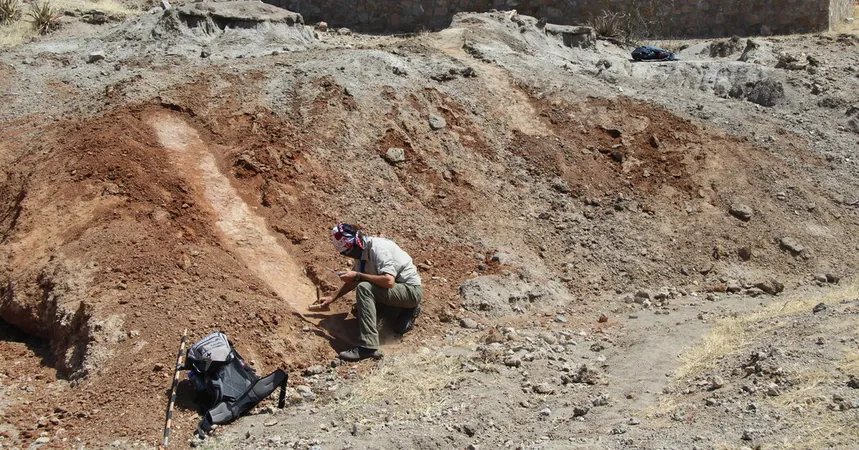
Unveiling the Secrets of Homo Erectus: Our Extinct Cousins Defied the Odds in a Harsh Desert!
2025-01-20
Author: Yan
Introduction
While chimpanzees rove in the lush rainforests of Africa and orangutans swing through the jungles of Indonesia, humans have claimed nearly every corner of the Earth. From icy tundras to soaring mountain peaks, our species has proven remarkably adaptable. But a groundbreaking study suggests that our ancient relatives may have shared this incredible resilience.
The Discovery of Homo Erectus in Harsh Environments
Recent research has revealed that Homo erectus, an extinct ancestor of modern humans, not only survived but thrived in a brutal desert environment around one million years ago—a time when such conditions were deemed inhospitable by many scientists. This finding challenges the traditional narrative that adaptability is a singular trait of Homo sapiens.
Expert Insights
Julio Mercader, an archaeologist at the University of Calgary and a lead author of the study published in the journal Communications Earth and Environment, stated, “This shifts our understanding of adaptability, expanding it beyond Homo sapiens to also include earlier relatives.”
The Research Site: Engaji Nanyori
For decades, fossils of early human forerunners indicated that these hominins had predominantly resided in open woodlands, far from extreme environments. The research team focused on Engaji Nanyori in northern Tanzania, a site rich in Homo erectus fossils, to better understand the environmental challenges faced by these ancient beings.
Homo Erectus: The Profile
Homo erectus emerged roughly 2 million years ago, developing features akin to modern humans, such as larger brain size and longer legs designed for running. They are believed to have migrated from Africa and spread to locations as distant as Indonesia, where they eventually went extinct around 100,000 years ago.
Adaptability in Action
To uncover how Homo erectus adapted to their changing habitat, Mercader and his team meticulously examined fossilized pollen, rock chemistry, and other environmental indicators at Engaji Nanyori. Their analysis unveiled a dramatic transition: what was once a comfortable woodland transformed into an arid desert shrubland, reminiscent of the Mojave Desert.
Survival Tactics of Homo Erectus
So, how did Homo erectus manage to not only survive but thrive in such unforgiving conditions? Instead of fleeing to more hospitable areas, they displayed remarkable adaptability. “Their greatest asset was their adaptability,” Mercader explained.
Innovative Strategies
These ancient hominins altered their scavenging techniques, strategically exploiting ephemeral ponds and streams that emerged after storms. Not only did they quench their thirst at these watering holes, but they also seized the opportunity to hunt the animals drawn to these temporary resources, butchering thousands of carcasses.
Advancements in Tool-Making
Moreover, they refined their tool-making skills, demonstrating an understanding of the materials best suited for crafting sharp implements. They became increasingly selective about their tool sources, choosing specific types of stone, and they learned to carry their carefully crafted tools in anticipation of future needs.
Geological Insights
Dr. Paul Durkin, a geologist involved in the research, emphasized that these strategies could have facilitated Homo erectus's eventual migration across continents, as they adapted to various challenging climates.
The Role of Climate Models
Additionally, researchers like Dr. Zeller are creating sophisticated climate models to analyze the different environmental conditions throughout hominin evolution. Their findings corroborate that Homo erectus could thrive in climates previously thought to be too severe for any hominin species.
Conclusion: A New Perspective
Together, the combined research efforts are painting a new picture—a narrative that showcases the adaptability of our ancient ancestors, compelling scientists to reevaluate the deep history of survival and innovation among hominins. “We definitely have to look further back in time to understand our adaptability,” Zeller concludes.
Legacy of Homo Erectus
Homo erectus may be long extinct, but their legacy as pioneers of adaptability continues to reshape our understanding of human evolution! What other secrets about our ancestors lie buried in the sands of time?


 Brasil (PT)
Brasil (PT)
 Canada (EN)
Canada (EN)
 Chile (ES)
Chile (ES)
 Česko (CS)
Česko (CS)
 대한민국 (KO)
대한민국 (KO)
 España (ES)
España (ES)
 France (FR)
France (FR)
 Hong Kong (EN)
Hong Kong (EN)
 Italia (IT)
Italia (IT)
 日本 (JA)
日本 (JA)
 Magyarország (HU)
Magyarország (HU)
 Norge (NO)
Norge (NO)
 Polska (PL)
Polska (PL)
 Schweiz (DE)
Schweiz (DE)
 Singapore (EN)
Singapore (EN)
 Sverige (SV)
Sverige (SV)
 Suomi (FI)
Suomi (FI)
 Türkiye (TR)
Türkiye (TR)
 الإمارات العربية المتحدة (AR)
الإمارات العربية المتحدة (AR)